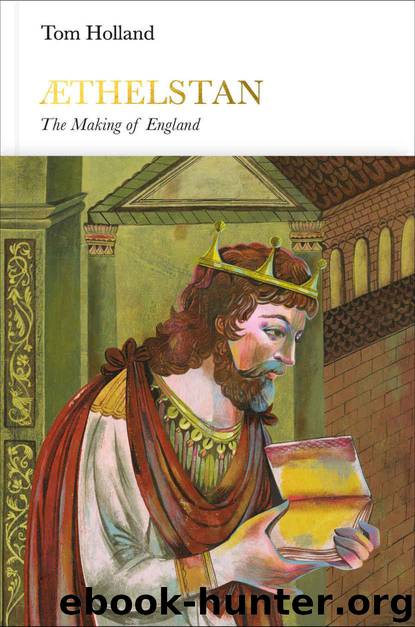Athelstan (Penguin Monarchs) by Holland Tom

Author:Holland, Tom [Holland, Tom]
Language: eng
Format: azw3
ISBN: 9780241187821
Publisher: Penguin Books Ltd
Published: 2016-06-29T16:00:00+00:00
4
Angelcynn
One year before the great durbar at Cirencester, while leading his army northwards against the King of the Scots, Athelstan arrived beside the River Wear. Here he halted his army and made a brief diversion. His destination was a wooden church built some fifty years previously amid the ruins of an old Roman fort. Athelstan’s enthusiasm for visiting Chester-le-Street was hardly surprising, for this small settlement contained treasures that richly merited a king’s attention. The monks who escorted their royal guest into the church led him to a coffin. Then, as he watched, they removed the lid, so that its contents were revealed to his view. Inside the coffin lay the head of Oswald. It was, for the nephew of Æthelflæd, who had redeemed the saint’s other mortal remains from the possession of the heathen, and brought them to Gloucester, an awe-inspiring thing to behold. There was, though, reverently laid beside it, an even more remarkable sight: a body wrapped in sumptuous silks and jewels, as incorrupt as on the very day that breath had left it. Nothing else in Britain could rival this corpse for sheer supernatural potency. Its holiness was manifest: a comfort to the faithful, a terror to the pagan. No wonder, then, that a king as renowned for his piety as Athelstan should have paused in his expedition and come to pay his respects to Saint Cuthbert.
The bond between the house of Wessex and the most celebrated ascetic in Northumbria’s history was a natural one. Both shared the same foe. Lindisfarne, the small island just north of Bamburgh where Cuthbert had originally been buried, had been pillaged by the Vikings as far back as 793: the very first monastery in Britain to be ‘ravaged by heathen savages’.1 By 875, with the Christian kingdom of Northumbria in ruins, the monks of the priory had despaired of their exposed location. Disinterring the body of their saintly patron, they had fled the island. An attempt to cross to Ireland had been halted when the Almighty battered their ship with waves of blood. Only in 883 had they finally settled at Chester-le-Street. Here, Cuthbert had shown himself more than capable of defending his own. Those who failed to treat him with due respect were struck with madness and a loathsome stench. Others, though, might be marked out by his favour to no less effect. Not long after his reburial, the saint had ordered an abbot to go to the Viking camp, and proclaim as king ‘the slave of a certain widow’;2 and after the Vikings, miraculously swayed by this command, had done so, the new king had displayed his gratitude by granting Cuthbert a great swathe of lands south of the Tyne. Even the most inveterate of the pagans in York had known better than to risk the saint’s anger by attempting to steal it back – until, that was, Ragnald had come to power. Appropriating Cuthbert’s patrimony, he had divided it between two of his followers: ‘sons of the Devil’ both.
Download
This site does not store any files on its server. We only index and link to content provided by other sites. Please contact the content providers to delete copyright contents if any and email us, we'll remove relevant links or contents immediately.
| Military | Political |
| Presidents & Heads of State | Religious |
| Rich & Famous | Royalty |
| Social Activists |
Waking Up in Heaven: A True Story of Brokenness, Heaven, and Life Again by McVea Crystal & Tresniowski Alex(37494)
Empire of the Sikhs by Patwant Singh(22774)
We're Going to Need More Wine by Gabrielle Union(18641)
Hans Sturm: A Soldier's Odyssey on the Eastern Front by Gordon Williamson(18332)
Leonardo da Vinci by Walter Isaacson(12810)
The Radium Girls by Kate Moore(11627)
Tools of Titans by Timothy Ferriss(7824)
Educated by Tara Westover(7694)
How to Be a Bawse: A Guide to Conquering Life by Lilly Singh(7162)
Permanent Record by Edward Snowden(5546)
The Last Black Unicorn by Tiffany Haddish(5418)
The Rise and Fall of Senator Joe McCarthy by James Cross Giblin(5151)
Promise Me, Dad by Joe Biden(4912)
The Wind in My Hair by Masih Alinejad(4850)
The Crown by Robert Lacey(4578)
A Higher Loyalty: Truth, Lies, and Leadership by James Comey(4558)
The Iron Duke by The Iron Duke(4126)
Joan of Arc by Mary Gordon(3790)
Stalin by Stephen Kotkin(3730)
